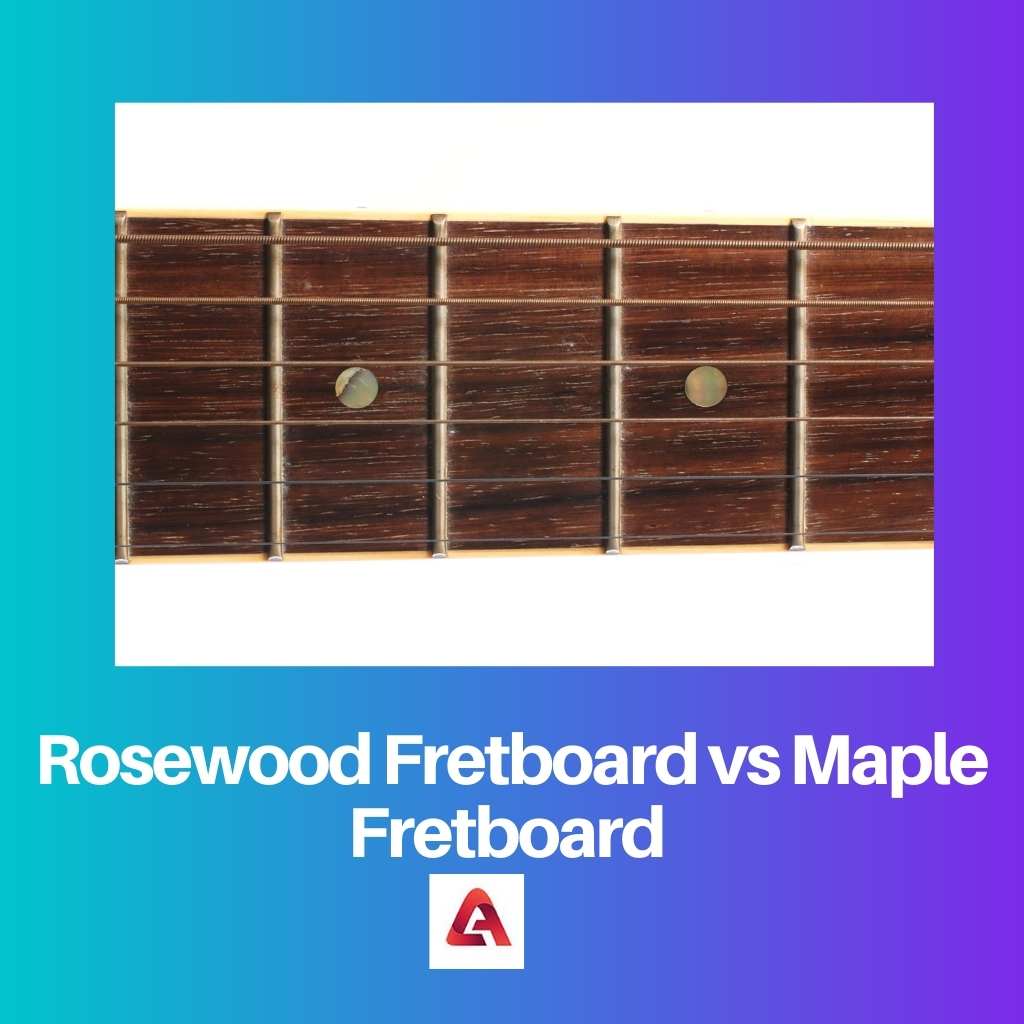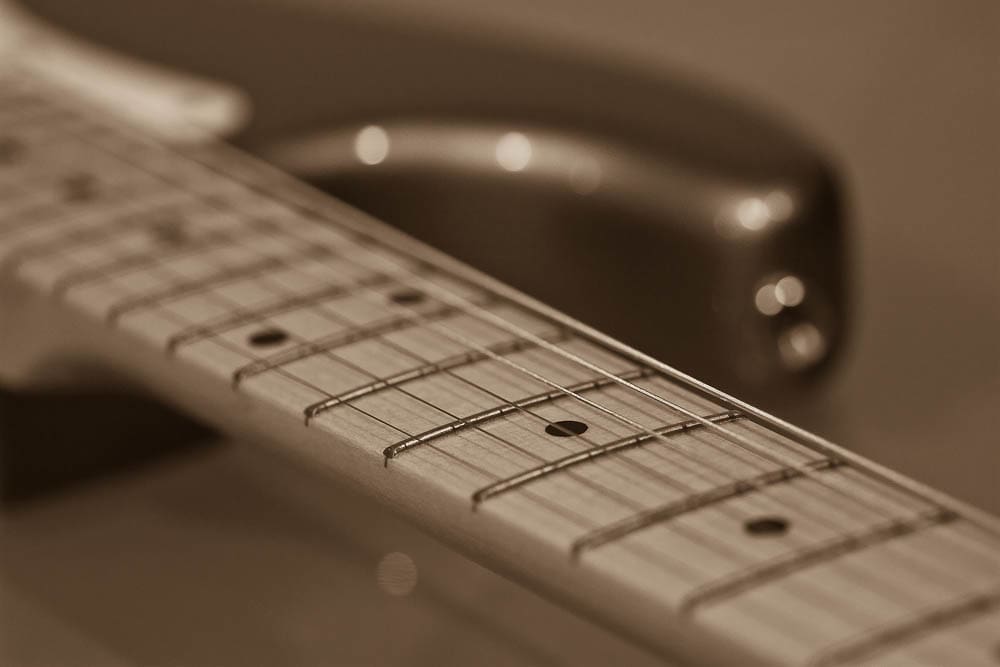The guitar is a fretted musical instrument that has 6 strings. It is played by strumming the strings while simultaneously pressing them against the fret.
Guitars come in a variety of types and can have different fretboard materials. Rosewood and Maple are two common types of fretboard materials used for making guitars.
Key Takeaways
- Rosewood and maple are two common types of wood used to create fretboards for guitars, each offering unique tonal qualities and aesthetic characteristics.
- Rosewood fretboards are known for their warm, rich tone and natural oiliness, contributing to a smoother playing experience. In contrast, maple fretboards are brighter and snappier, providing a distinct tonal clarity.
- Aesthetically, rosewood has a darker color and more prominent grain. In contrast, maple is lighter in color and may feature various grain patterns, such as birdseye or flame maple, that can influence the guitar’s appearance and value.
Rosewood Fretboard vs Maple Fretboard
A rosewood fretboard is a guitar fretboard. It has a grainy texture. It is not expensive. Sweet tones are generated by it. Lemon oil is used for the maintenance of rosewood fretboard. Brighter tones can be produced with maple fretboard. It is mostly available in light colors. The cleaning of the maple fretboard is easy.

A Rosewood Fretboard is a reddish-brown fretboard and is the most common type of guitar fretboard. It is popular because of being cheap, plentiful, and easy to work with. It is distinguishable from other types of fretboards because of its grainy texture.
It is known for producing warm and sweet tones, as overtones get absorbed in its porosity.
A Maple Fretboard is a cream-colored fretboard, which is preferred for producing brighter tones with more overtones that do not get absorbed due to its density and low porosity.
It is known for producing snappy and precise and is distinguished from other fretboard types due to having a glossy finish that makes it smooth.
Comparison Table
| Parameters of Comparison | Rosewood Fretboard | Maple Fretboard |
|---|---|---|
| Color | A Rosewood Fretboard is available in shades of caramel brown. | A Maple Fretboard is lighter in color, sometimes almost white. |
| Feel | Rosewood is naturally oily, more porous, and a bit coarse. | Maple is dense and is given a nitrocellulose finish or lacquer coat that makes it smooth and glossy. |
| Playability | Being open-grained, Rosewood provides a better grip over the neck and enhances string bending and other techniques. | Being glossy, Maple Fretboards can become sticky, limiting their playability. |
| Sound | A Rosewood Fretboard produces spacious and warm tones. | A Maple Fretboard provides note clarity and produces punchy tones with more overtones. |
| Maintenance | Rosewood Fretboards are prone to drying and hence are oiled with lemon oil. | Maple Fretboards being covered with a lacquer coat are easier to clean, however, they are notorious for showing signs of wear over time. |
What is Rosewood Fretboard?
Rosewood Fretboards are the least expensive and most famous type of guitar fretboards, offered by a range of manufacturers like Fender, Gibson, PRS, and Ibanez.
It is of two types, viz. Indian and Brazilian Rosewood and is distinguished by its grainy texture and unique reddish-brown color, which is darker than Maple but lighter than Ebony, the two other famous fretboard types.
The Rosewood Fretboard’s texture is characterized by loose grains and slight ridges in the wood. It is the heaviest wood and has a natural oil finish.
This texture of Rosewood enables it to produce warm tones, as the harmonics get compressed due to its grainy and oily texture. The texture also determines its playability, enhanced due to the better grip associated with this type.
Rosewood Fretboards started appearing in the 1850s. During this time, guitars started becoming an instrument for common people.
They had been restricted to dukes and lords and had expensive and lustrous materials like ivory and pearl as their fretboard materials. The innovation of Antonio de Torres made them popular.
They have an irregular surface because of being open-grained and hence are more prone to the collection of debris and dirt. They thus require regular cleaning and maintenance using lemon oil, which prevents its drying.

What is Maple Fretboard?
Maple Fretboards are unique in their near-white appearance and are used in classic Fender designs like Stratocaster and Telecaster.
They can be manufactured in two ways; first, by using a single piece of Maple wood both as the neck and fretboard. Second, by using Maple wood with Mahogany to make a fretboard.
The Maple Fretboard’s texture is characterized by fine grains and dense hardwood. The hardwood used in its production is sourced from North America and Canada, which gives it a light color.
This fine-grained texture of Maple enables it to produce soothing and bright tones with prominent ends, as it has a higher attack that makes the sound snappy.
Fenders introduced Maple Fretboards to add strength to the overall design as well as to keep repair and manufacturing simple. They were first made as a one-piece maple neck and were later made along with other woods like Mahogany.
They are also characterized by a finish, which could be lacquer, satin, matte, or gloss; although it enhances its playability, it tends to get worn down over time.
This finish makes it easy to clean. However, its removal over time deteriorates the quality of the guitar, as dirt and dust get accumulate in the wood.

Main Differences Between Rosewood Fretboard and Maple Fretboard
- Rosewood and Maple Fretboards differ based on their appearance. Rosewood Fretboards are dark in color, having varying shades of caramel brown. On the other hand, Maple Fretboards are light in color, almost close to white.
- Rosewood and Maple Fretboards are distinct in terms of their feelings. While Rosewood Fretboards are porous, naturally oily, and coarse-grained, Maple Fretboards are dense, fine-grained, and coated with lacquer.
- Different feels of the fretboards make a difference in their playability. Rosewood fretboards are easy to grip over due to being open-grained. Maple fretboards sometimes have limited playability because of being sticky.
- Rosewood and Maple Fretboards produce different types of tones and are hence preferred differently by players for different occasions. Rosewood produces warm tones, whereas Maple produces punchy tones.
- Different fretboards have different procedures for their cleanliness and maintenance. Rosewood Fretboards are prone to getting dry with time and are hence oiled. Maple Fretboards are comparatively easy to clean because of having a lacquer coat.

References
- https://link.springer.com/article/10.1007/s00107-020-01631-9
- https://direct.mit.edu/lmj/article-abstract/doi/10.1162/LMJ_a_00087/63516
